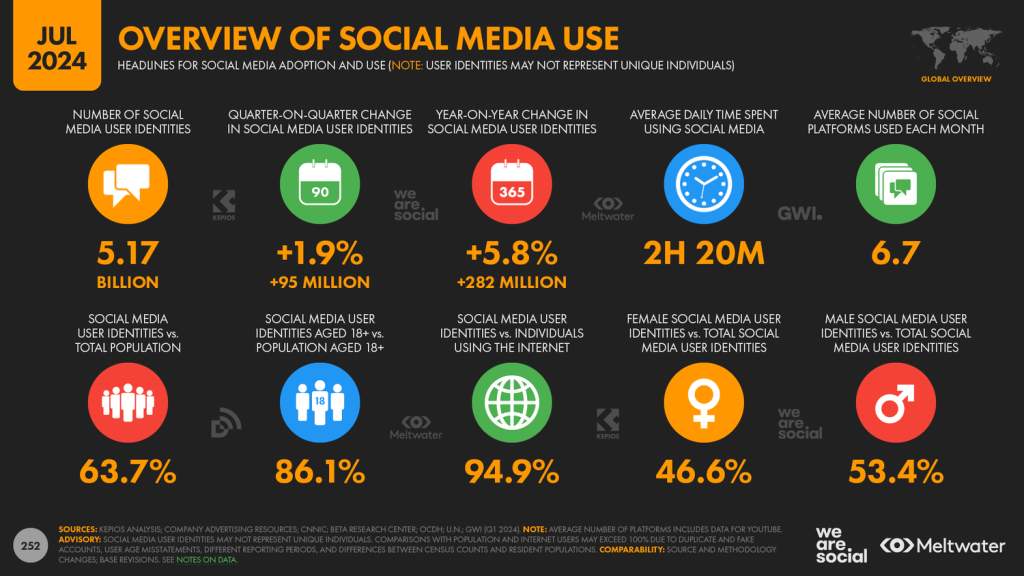The marketing world is dynamic and ever-changing. As the marketing landscape continues to evolve, staying informed on the latest statistics is essential for businesses looking to refine their strategies and maximize ROI. Staying ahead or on top of the latest numbers is a vital way to ensure the success of any business.
Several key trends and insights have emerged that can significantly influence marketing efforts. Here’s a comprehensive list of important marketing statistics, complete with sources and links for further exploration.
1. Digital Advertising Spend
Digital advertising continues to dominate marketing spending as businesses increasingly allocate resources to online channels. With significant growth, understanding the latest trends in ad spending and formats can help brands optimize their marketing strategies for maximum impact.
Projected Growth: Global spending on digital advertising is set to reach $740.3 billion in 2024, which increase of 13% from the previous year. This surge demonstrates the shift from traditional advertising to digital platforms as brands seek more targeted and measurable ways to reach consumers.
Ad Formats: Video ads are expected to dominate, with projected growth in ad spending up to $191.3 billion with a growth rate of 6.04%. This growth indicates the increasing effectiveness of video content in engaging consumers.
2. Social Media Engagement
Social media platforms have become essential tools for brand visibility and customer interaction in the digital landscape. With billions of users actively engaging with content, understanding which platforms and strategies yield the highest engagement is crucial for effective marketing.
Active Users
As of 2024, over 5.17 billion people are active on social media, representing a 63.7% penetration rate globally. This staggering number emphasizes the critical role social media plays in marketing strategies. Brands can leverage these platforms to reach a vast audience, engage directly with customers, and build community around their products or services.
Popular Platforms
Facebook: With approximately 3.07 billion monthly active users, Facebook remains the largest social media platform. Its extensive user base provides brands with a unique opportunity to target a wide demographic range through advanced advertising tools and engagement features.
Instagram: Instagram continues to grow rapidly, particularly among younger audiences. With features like Stories, Reels, videos, and Shopping, it offers brands innovative ways to engage users and showcase products visually. Engagement rates on Instagram average over 3%, making it one of the most effective platforms for brand interaction.
TikTok: This platform has skyrocketed in popularity, especially among Gen Z and millennials. Its short-form video content format fosters high engagement, with users spending significant time watching and interacting with videos. Brands are increasingly using TikTok to create authentic and entertaining content that resonates with younger audiences.
Influencer Marketing
The influencer marketing industry is projected to reach $24 billion in 2024, showcasing brands’ reliance on influencers for authentic engagement and broader reach. Influencers can effectively bridge the gap between brands and customers, providing a level of trust and relatability that traditional advertising often lacks. By partnering with influencers who align with their values and target audience, brands can enhance their visibility and drive conversions.
3. Email Marketing Effectiveness
Email marketing remains one of the cornerstones of digital marketing strategies. It delivers high ROI and offers personalization opportunities. Understanding how to optimize email campaigns can significantly impact engagement and conversion rates.

Return on Investment (ROI): In terms of ROI, email marketing garners a $36 return for every dollar spent, which makes it one of the most effective marketing channels.
Personalization Impact: 75% of marketers report that personalized email content improves engagement rates. Tailoring emails based on user behaviour and preferences can significantly enhance open and click-through rates.
4. Content Marketing Insights
Quality content is essential for attracting and retaining customers. As consumers become more discerning, seeking valuable information rather than mere promotional material, brands must prioritize effective content strategies. This includes blogging, video content, and social media engagement to create a cohesive and impactful marketing approach.
Content Consumption: Consumers are spending an average of 3 hours per day consuming digital content across various platforms. This statistic underscores the importance of producing high-quality, engaging content that resonates with target audiences. Brands that invest in understanding their consumers’ preferences and behaviours can craft content that not only informs but also entertains and inspires action.
Blogging: Blogs remain a cornerstone of content marketing strategies. Companies that maintain a blog posting to their websites generate 67% more leads than those that do not. This highlights the significance of consistent blogging in driving organic traffic and improving SEO rankings.
Video Content: The rise of video content is undeniable, with 91% of businesses utilizing it as a marketing tool. Video not only drives engagement but also significantly boosts SEO performance. Web pages that include video are more likely to rank on the first page of Google compared to those without video.
5. SEO Trends
Search engine optimization (SEO) remains a crucial aspect of digital marketing, as it directly impacts visibility for brands. Understanding the latest trends can help marketers improve their search rankings and drive organic traffic.
SEO Priorities: Approximately 39% of marketers prioritise improving and optimizing on-page content based on keywords as their top SEO strategy.
Voice Search Optimization: In 2024, 41% of people use voice search daily. It’s highlighting the need for businesses to optimize content for voice queries. This shift calls for a focus on natural language and local SEO strategies.
Mobile Optimization: Over 63% of searches are now conducted on mobile devices, making mobile optimisation critical for SEO strategies. Websites that are not mobile-friendly risk losing significant traffic.
Validate Your Email Data with a Quick Check
Perform a Quick Data Validation Here
Final Thought
Staying updated with the latest trends and practices in marketing can feel overwhelming sometimes. The industry is always changing, with ever-changing technologies.
However, by keeping insights into the most recent and trending marketing statistics, you can equip your team for success and maintain a competitive edge. By leveraging these insights, marketers can make data-driven decisions that enhance their strategies and drive business growth.
James P. is Digital Marketing Executive at MyEmailVerifier. He is an expert in Content Writing, Inbound marketing, and lead generation. James’s passion for learning about people led her to a career in marketing and social media, with an emphasis on his content creation.

